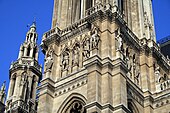
Vienna is the capital, most populous city, and one of nine federal states of Austria. It is Austria's primate city, with just over two million inhabitants. Its larger metropolitan area has a population of nearly 2.9 million, representing nearly one-third of the country's population. Vienna is the cultural, economic, and political center of the country, the fifth-largest city by population in the European Union, and the most-populous of the cities on the Danube river.
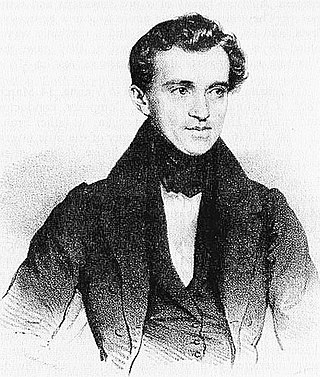
Johann Baptist Strauss I, also known as Johann Strauss Sr., the Elder or the Father, was an Austrian composer of the Romantic Period. He was famous for his light music, namely waltzes, polkas, and galops, which he popularized alongside Joseph Lanner, thereby setting the foundations for his sons—Johann, Josef and Eduard—to carry on his musical dynasty. He is best known for his composition of the Radetzky March.
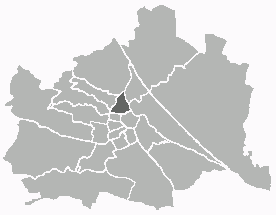
Alsergrund is the ninth district of Vienna, Austria. It is located just north of the first, central district, Innere Stadt. Alsergrund was incorporated in 1862, with seven suburbs. As a central district, the area is densely populated. According to the census of 2001, there were 37,816 inhabitants over 2.99 square km.
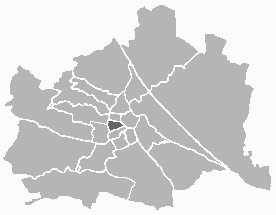
Neubau is the seventh district of Vienna. It is located near the center of Vienna and was established as a district in 1850, but borders changed later. Neubau is a heavily populated urban area, with a major shopping area and residential buildings. It has a population of 32,027 people within an area of 1.61 km² (0.62 sq.mi.).

The Innere Stadt is the 1st municipal district of Vienna located in the center of the Austrian capital. The Innere Stadt is the old town of Vienna. Until the city boundaries were expanded in 1850, the Innere Stadt was congruent with the city of Vienna. Traditionally it was divided into four quarters, which were designated after important town gates: Stubenviertel (northeast), Kärntner Viertel (southeast), Widmerviertel (southwest), Schottenviertel (northwest).

Josefstadt is the eighth district of Vienna. It is near the center of Vienna and was established as a district in 1850, but borders changed later. Josefstadt is a heavily populated urban area with many workers and residential homes. It has a population of 24,279 people (2014). With an area of 1.08 km2, Josefstadt is the smallest district in Vienna, and was named after the Holy Roman Emperor Joseph I.

Favoriten, the 10th district of Vienna, Austria, is located south of the central districts. It is south of Innere Stadt, Wieden and Margareten. Favoriten is a heavily populated urban area with many residential buildings, but also large recreational areas and parks.
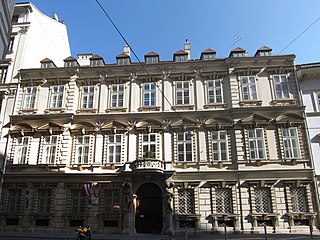
Palais Caprara-Geymüller, sometimes known as Palais Caprara, is a Baroque palace in Vienna, Austria. The Vienna Stock Exchange is situated in the palace.

Wiener Stadthalle is a multi-purpose indoor arena and convention center located in the 15th district of Vienna, Austria. Austrian architect Roland Rainer designed the original halls which were constructed between 1953 and 1958, and later expanded in 1974, 1994 and 2006. The main hall, a multi-purpose venue, is Austria's largest indoor arena with a seating capacity of approximately 16,152 people.
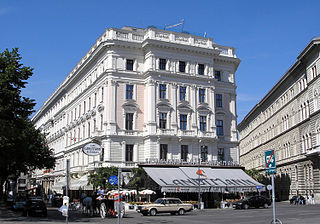
Café Landtmann is a traditional Viennese café located on the Ringstraße at the corner of Lowelstraße 22 in the Innere Stadt first district in Vienna, Austria.

The Carltheater was a theatre in Vienna. It was in the suburbs in Leopoldstadt at Praterstraße 31.

The German name Spinnerin am Kreuz is the title given to two separate Austrian stone-tower sculptures, one in Vienna and the other in the nearby city of Wiener Neustadt. They are related to the story of a wife spinning beside a cross. Both columns had been designed originally by Meister Michael Knab:

Augsburg Town Hall is the administrative centre of Augsburg, Bavaria, Germany, and one of the most significant secular buildings of the Renaissance style north of the Alps. It was designed and built by Elias Holl, Stadtbaumeister, in 1615–1624. Due to its historic and cultural importance, it is protected by the Hague Convention for the Protection of Cultural Property in the Event of Armed Conflict.

The Mozarthaus Vienna was Mozart's residence from 1784 to 1787. The building is located in Vienna's Old Town, not far from St. Stephen's Cathedral, and is his only surviving Viennese residence. It is now a museum.

Kursalon is a music hall in Vienna, designed by Johann Garben in the style of the Italian Renaissance and built between 1865 and 1867.

The following outline is provided as an overview of and topical guide to Vienna:

The Palais Erzherzog Ludwig Viktor is one of the best known Ringstraßenpalais in Vienna. It was built between 1863 and 1866. The first building to be built on the Schwarzenbergplatz, it is now a subsidiary house of the Burgtheater.

The Alte Rathaus is a building in central Vienna, located at Wipplingerstraße 8, 1st District.

The Michaelerplatz is a major square in the center of Vienna. It is a baroque, star-shaped square that functions as the point of intersection of several inner-city streets – the Kohlmarkt, the Herrengasse, the Schauflergasse, and the Reitschulgasse – as well as the northeast entry point to the Hofburg. The square is named after St. Michael's Church, which lies on the eastern part of the Michaelerplatz.

The Reformed City Church of Vienna is a church building that belongs to the Evangelical Church of the Helvetic Confession in Austria. It is located in Vienna's 1st municipal district, Innere Stadt, on Dorotheergasse.





